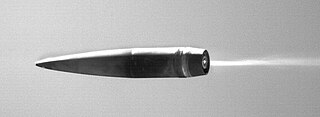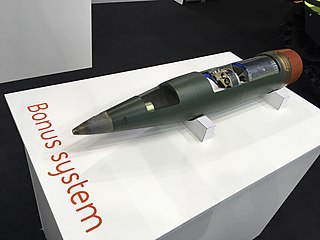
Shrapnel shells were anti-personnel artillery munitions which carried many individual bullets close to a target area and then ejected them to allow them to continue along the shell's trajectory and strike targets individually. They relied almost entirely on the shell's velocity for their lethality. The munition has been obsolete since the end of World War I for anti-personnel use; high-explosive shells superseded it for that role. The functioning and principles behind Shrapnel shells are fundamentally different from high-explosive shell fragmentation. Shrapnel is named after Lieutenant-General Henry Shrapnel (1761–1842), a British artillery officer, whose experiments, initially conducted on his own time and at his own expense, culminated in the design and development of a new type of artillery shell.

The M198 is a medium-sized, towed 155 mm artillery piece, developed for service with the United States Army and Marine Corps. It was commissioned to be a replacement for the WWII-era M114 155 mm howitzer. It was designed and prototyped at the Rock Island Arsenal in 1969 with firing tests beginning in 1970 and went into full production there in 1978. It entered service in 1979 and since then 1,600 units have been produced.

A cluster munition is a form of air-dropped or ground-launched explosive weapon that releases or ejects smaller submunitions. Commonly, this is a cluster bomb that ejects explosive bomblets that are designed to kill personnel and destroy vehicles. Other cluster munitions are designed to destroy runways or electric power transmission lines, disperse chemical or biological weapons, or to scatter land mines. Some submunition-based weapons can disperse non-munitions, such as leaflets.

A flechette is a pointed steel projectile with a vaned tail for stable flight. The name comes from French fléchette, "little arrow" or "dart", and sometimes retains the acute accent in English: fléchette. They have been used as ballistic weapons since World War I. Delivery systems and methods of launching flechettes vary, from a single shot, to thousands in a single explosive round. The use of flechettes as antipersonnel weapons has been controversial.

High-explosive anti-tank (HEAT) is a type of shaped charge explosive that uses the Munroe effect to penetrate heavy armor. The warhead functions by having an explosive charge collapse a metal liner inside the warhead into a high-velocity superplastic jet; this is capable of penetrating armor steel to a depth of seven or more times the diameter of the charge. The jet's effect is purely kinetic in nature; the round has no explosive or incendiary effect on the target.

Plunging fire is a form of indirect fire, where gunfire is fired at a trajectory to make it fall on its target from above. It is normal at the high trajectories used to attain long range, and can be used deliberately to attack a target not susceptible to direct or grazing fire due to not being in direct line of sight.

A shell, in a military context, is a projectile whose payload contains an explosive, incendiary, or other chemical filling. Originally it was called a bombshell, but "shell" has come to be unambiguous in a military context. Modern usage sometimes includes large solid kinetic projectiles that is properly termed shot. Solid shot may contain a pyrotechnic compound if a tracer or spotting charge is used.

The M270 Multiple Launch Rocket System is an American armored, self-propelled, multiple rocket launcher.

The M982 Excalibur is a 155 mm extended range guided artillery shell developed during a collaborative effort between the U.S. Army Research Laboratory (ARL) and the United States Army Armament Research, Development and Engineering Center (ARDEC). The Excalibur was developed and/or manufactured by prime contractor Raytheon Missiles & Defense, BAE Systems AB and other subs and primes in multiple capacities such as Camber Corporation and Huntington Ingalls Industries. It is a GPS- and inertial-guided munition capable of being used in close support situations within 75–150 meters (250–490 ft) of friendly troops or in situations where targets might be prohibitively close to civilians to attack with conventional unguided artillery fire. In 2015 the United States planned to procure 7,474 rounds with a FY2015 total program cost of US$1.9341 billion at an average cost of US$258,777 per unit. By 2016, unit costs were reduced to US$68,000 per round. Versions that add laser-guidance capability and are designed to be fired from naval guns began testing in 2015. As of October 2018, over 1,400 rounds had been fired in combat.

Project Sense and Destroy ARMor, or SADARM, is a United States 'smart' submunition capable of searching for, and destroying tanks within a given target area.

The 2S4 Tyulpan is a Soviet 240 mm self-propelled heavy mortar. "2S4" is its GRAU designation. The Tyulpan is the largest mortar system in use today.
The M864 is an American made 155 mm artillery shell. It carries a dual-purpose ICM submunition warhead and incorporates base bleed technology to increase its range. The projectile is capable of delivering 24 M46 and 48 M42 dual-purpose anti-materiel/anti-personnel sub-munitions at ranges out to 29 kilometers. Base bleed technology was developed to reduce the amount of base drag on a projectile, thereby increasing the achieved range. The drag is reduced by a gas generator located on the base of the projectile. Once ignited, the gas generator bleeds hot gas into the projectiles wake which causes the flow of air at the base to be less turbulent. The decrease in turbulence, reduces base drag, which typically accounts for 50 percent of total drag. The amount of thrust produced by the base burner unit is negligible and does not serve the same function as the rocket motor on a rocket-assisted projectile (RAP).

The Extended Range Guided Munition was a precision guided rocket-assisted 5-inch (127 mm) Shell (projectile) development by Raytheon for the U.S. Navy. The program was cancelled in March 2008 after twelve years of development and over 600 million dollars in funding. The developmental round was designated EX 171. ERGM consisted of three major subsections; propulsion, warhead, and Guidance, Navigation and Control section. ERGM is fired from the 127 mm (5 inch) 62 Caliber Mark 45 gun Mod 4 at which point the fins deploy, rocket motor would ignite and lift the munition to at least 80,000 feet (24 km) when the canards would deploy and guide the ERGM to the target based on GPS guidance. It was to be used on Arleigh Burke class destroyers.

A rocket-assisted projectile (RAP) is a cannon, howitzer, mortar, or recoilless rifle round incorporating a rocket motor for independent propulsion. This gives the projectile greater speed and range than a non-assisted ballistic shell, which is propelled only by the gun's exploding charge. Some forms of rocket-assisted projectiles can be outfitted with a laser-guide for greater accuracy.

The 2K25 Krasnopol is a Soviet 152/155 mm cannon-launched, fin-stabilized, base bleed-assisted, semi-automatic laser-guided, artillery weapon system. It automatically 'homes' on a point illuminated by a laser designator, typically operated by a drone or ground-based artillery observer. Krasnopol projectiles are fired mainly from Soviet self-propelled howitzers such as the 2S3 Akatsiya and 2S19 Msta-S and intended to engage small ground targets such as tanks, other direct fire weapons, strong-points, or other significant point targets visible to the observer. It can be used against both stationary and moving targets.

Ammunition is the material fired, scattered, dropped or detonated from any weapon or weapon system. Ammunition is both expendable weapons and the component parts of other weapons that create the effect on a target.

A precision-guided munition is a guided munition intended to precisely hit a specific target, to minimize collateral damage and increase lethality against intended targets. During the First Gulf War guided munitions accounted for only 9% of weapons fired, but accounted for 75% of all successful hits. Despite guided weapons generally being used on more difficult targets, they were still 35 times more likely to destroy their targets per weapon dropped.
The MAT-120 cargo bomb is a Spanish-produced cluster munition, fired from a 120mm calibre mortar produced by Instalaza SA. The main body of the round holds dual-purpose anti-tank/anti-personnel submunitions. The MAT-120 submunitions are unique in that to prevent the dangers of unexploded duds, there is a double redundant feature the manufacturer refers to as self-destruction and self-sterilization. This prevents unexploded MAT-120 submunitions from lying around becoming de facto landmines, dangerous to both combatants and non-combatants.
SMArt 155 is a German 155 mm artillery round, designed for a long range, indirect fire top attack role against armoured vehicles. The SMArt carrier shell contains two submunitions with infrared sensor and millimeter wave radar, which descend over the battlefield on ballutes and attack hardened targets with explosively formed penetrator warheads. Built with multiple redundant self-destruct mechanisms, these submunitions were specifically designed to fall outside the category of submunition weapons prohibited by the 2008 Convention on Cluster Munitions.

155 BONUS is a 155 mm artillery cluster round, developed in cooperation between Bofors of Sweden and Nexter of France, designed for a long range, indirect fire top attack role against armoured vehicles. The BONUS base bleed carrier shell contains two submunitions, which descend over the battlefield on winglets and attack hardened targets with explosively formed penetrator warheads.

















